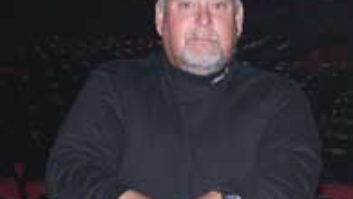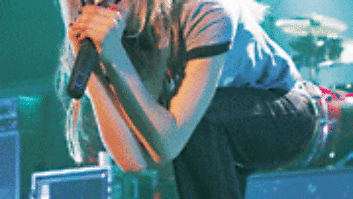
Photo: Steve Jennings
“Don’t cross me,” Dido teases, introducing her song “See You When You’re 40” during one of two nights at Berkeley, Calif.’s Community Theatre. Despite her gentle voice and petite frame, the British singer/songwriter proves her point onstage, when one enthusiastic fan shouts, “You’ve got a sexy ass!” “Who cares about the songs — it’s all about the ass,” she jokes wryly, and then continues a set of cool, modern pop.
The London native became an international star when rapper Eminem sampled “Thank You” from her 1999 debut, No Angel, on his hit, “Stan.” Supporting her 2003 follow-up, Life for Rent, Dido kicked off the U.S. leg of this tour in mid-May, with production provided by Canada-based Sound Arts.

From left: system engineer Jamie Howieson, monitor tech Korey Sherwin, monitor engineer Paul McManus and FOH engineer Mark LeCorre
Photo: Steve Jennings
Front-of-house engineer Mark LeCorre mixes the six-piece band on a Yamaha PM-1D console. “We decided to beef things up sonically,” LeCorre says. “We’re running 48 channels of True Precision 8 preamps — bypassing the Yamaha preamps — into the line inputs on the PM-1D. We’re also clocking with the Big Ben.”
For Dido’s vocals, LeCorre uses Focusrite mic pre’s and his own Pro Tools|HD rig. “I run her vocal through the Focusrite ISA 110 onstage and then line-in to the ISA 220 for EQ and compression,” he says. “From there, I go directly to Pro Tools and run her through the Waves C4 multiband compressor, a Waves de-esser and the Bomb Factory LA-2A. I use plug-ins for dynamics processing on almost all the tracks. I also use a TC System 6000 for vocal effects and reverbs and the PM-1D for instrument reverbs and delays. There are a lot of effects cues in the show and it would be hard to reproduce them consistently every night without a digital desk. We’ve fully embraced the robots, we like to say!”
Dido sings through a Sennheiser SKM5000 handheld transmitter paired with an 865 capsule. The mic setup also includes Shure SM91s and SM57s, Sennheiser 609s, 604s and E602s and Neumann KM184s, all used on drummer Alex Alexander’s kit and Jodi Linscott’s elaborate percussion rig. A pair of Sennheiser MKH 416s serve as audience mics. Bassist Keith Golden and guitarist Vini Miranda use Line 6 Pod Pro, with Miranda adding an Avalon 767 stereo compressor. Both instruments and John Deley’s keyboards run direct.
These delay-laden instruments, percussion samples and ethereal effects are presented through a Meyer P.A. system: 20 Milo self-powered loudspeakers and two M3D subs flown per side and four M3D subs on the ground per side. “I use MSL-4s on the stage side of the subs to the centers of row three to six and eight UPM-1Ps across the lip of the stage,” adds system engineer Jamie Howieson. “I also have two UPA-2Ps for coverage right in front of the subwoofers. This gives the people sitting in front of the subs some mid- and high-frequency intelligibility.”
Howieson uses a host computer to run XTA Audio core, SIA Smaart Live software, .WAV files and the PM-1D PC software to operate and tune the system. The computer talks to a wireless tablet PC, which he uses with a wireless test mic to tune various zones in the venue. “I can go to the zone and measure it, play music and actually listen to it with my ears.”
Monitor engineer Paul McManus creates six stereo mixes for Dido and band on a second PM-1D, using 24 outputs and seven of the board’s eight effects. “I’ve got vocal delay on about half of the songs and hi-hat delay — stuff that’s on the record that they want to hear.”
McManus uses a Focusrite ISA220 on Dido’s vocals and a Manley leveling amp for the two bass lines. McManus also takes a dry guitar line for Dido. “That goes through one side of a dbx 160 SL,” he adds, “I insert the other side of that on her acoustic guitar.”
Dido and band all use a Sennheiser-provided EW300 ear monitor system — Dido and McManus wear the G2 Series — with Westone ES-2 custom mold dual drivers. “The techs get a spare pack so they can hear what their guy is listening to,” McManus adds. One Electro-Voice X-Line double 18-inch sub per side also helps.
“Live, it’s about trying to get more of that reggae dub thing with lots of big bottom end,” LeCorre says. “To get those two worlds together — powerful yet pristine — that’s a unique challenge.”




